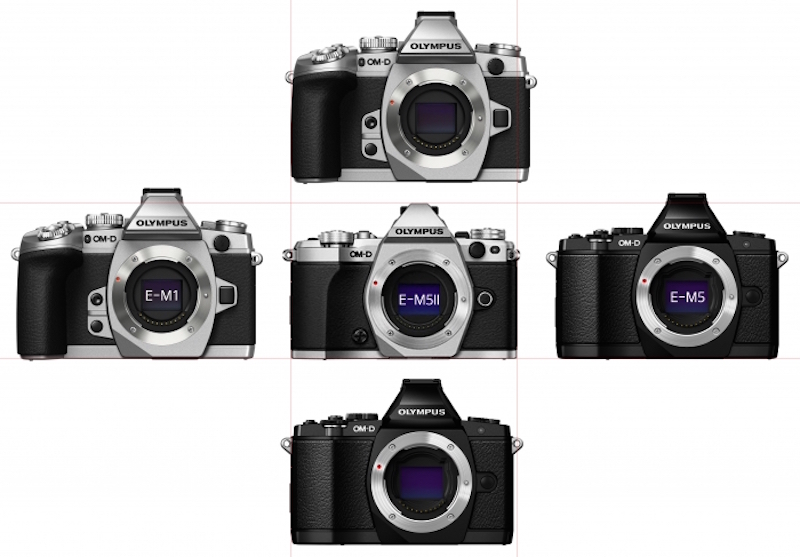Olympus E-M5 Mark II announced with 5-axis image stabilization, a 40-megapixel high-resolution shot mode, sophisticated, stunning HD video, integrated Wi-Fi and a variable-angle 3-inch touchscreen. Olympus E-M5II vs E-M5 vs E-M1 specifications comparison table can be seen below.
The Olympus E-M5II mirrorless camera boasts a 40MP high resolution shot mode, achieved by shifting the sensor in half-pixel steps and capturing eight images over a period of one second. The camera announced in February, 2015.
The OM-D E-M5 is a micro four thirds camera announced back in February 2012. The E-M5 features a 16 megapixel sensor, ISO up to 25,600, high resolution 1.4million dot EVF, built-in image stabilization and tiling touch screen.
The Olympus OM-D E-M1 announced back in September 2013. It features a 16.3 megapixel Live MOS sensor and TruePic VII image processor. The OM-D E-M1 has on-chip phase detection, which promises to focus legacy Four Thirds lenses (using the optional MMF-3 adapter) at much faster speeds than previous Olympus m4/3 cameras.
Olympus E-M5II vs E-M5 vs E-M1 Specifications Comparison
To see the difference between Olympus E-M5II vs E-M5 vs E-M1 Micro Four Thirds cameras we have put together E-M5II vs E-M5 vs E-M1 specs comparison table below.
Below you can see the specs comparison table of Olympus E-M5II vs E-M5 vs E-M1 mirrorless cameras. Some differences like sensor, image size, shooting speed, lcd size etc.. detailed as bold on the table.
| Feature | OM-D E-M5 Mark II | OM-D E-M5 | OM-D E-M1 |
|---|---|---|---|
| Sensor Resolution | 16.1 MP (40MP images) | 16.1 MP | 16.3 MP |
| Sensor Type | Four Thirds | Four Thirds | Four Thirds |
| Sensor Size | 17.3x13mm | 17.3x13mm | 17.3x13mm |
| On-sensor PDAF | No | No | Yes |
| Image Size | 4608 x 3456 | 4608 x 3456 | 4608 x 3456 |
| Image Processor | TruePic VII | TruePic VI | TruePic VII |
| In-body Image Stabilizer | Yes (5-Axis) | Yes (5-Axis) | Yes (5-Axis) |
| Viewfinder | Yes | Yes | Yes |
| Storage Media | SD/SDHC/SDXC | SD/SDHC/SDXC | SD/SDHC/SDXC |
| Continuous Shooting Speed | 10 FPS | 9 FPS | 10 FPS |
| Max Shutter Speed | 1/16000 to 60 sec | 1/4000 to 60 sec | 1/8000 to 60 sec |
| Native ISO Sensitivity | ISO 200-25,600 | ISO 200-25,600 | ISO 100-25,600 |
| Autofocus System | 81 points | 35 points | 81 points |
| Video Output | MPEG-4, H.264, Motion JPEG | H.264 | H.264 |
| Video Resolution | 1920 x 1080 (60, 50, 30, 25, 24 fps) | 1920 x 1080 (30p) | 1920 x 1080 (30p) |
| LCD Size | 3″ TFT-LCD | 3″ TFT-LCD | 3″ TFT-LCD |
| LCD Resolution | 2.36m dot LCD 1.48x mag | 1.44m dot LCD 1.15x mag | 2.36m dot LCD 1.48x mag |
| Exposure Compensation | ±5 (at 1/3 EV, 1/2 EV, 1 EV steps) | ±3 (at 1/3 EV steps) | ±5 (at 1/3 EV, 1/2 EV, 1 EV steps) |
| Flash | Clip-on Tilt/bounce/rotate | Clip-on Fixed direction | Clip-on Fixed direction |
| Wi-Fi | Yes | No | Yes |
| Mic Socket | Yes | No | Yes |
| Battery Life (CIPA) | 310 shots | 330 shots | 350 shots |
| USB Version | 2 | 2 | 2 |
| Dimensions | 124 x 85 x 45 mm | 121.9 x 88.9 x 43.1 | 130 x 94 x 63 mm |
| Weight | 469g | 425g | 497g |
| Current Prices | $1,099.00 | $599.00 | $1,399.00 |
Along with the announcement of the new OM-D E-M5II camera, Olympus also announced a new range of accessories including two new grips, a new underwater housing, as well as a Dot Sight accessory. The Olympus EE-1 dot sight for the OM-D E-M5 Mark II camera is designed to be used with long telephoto lenses when shooting fast moving subjects.

No comments:
Post a Comment